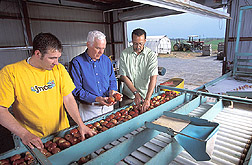Fresh Fruit Gets a Protective New Coat |
|
 From left, biological technician Erik Burchard and plant pathologists Charles Wilson and Ahmed El Ghaouth examine apples to evaluate the effectiveness of biological treatments for postharvest decay control. (K9927-2) |
Apples and citrus are about to get a new coat. But it's not to keep the fruit warm on cold orchard nights. Instead, these coatings act as biofungicides that keep fruit fresh longer during storage. Biological products for environmentally friendly pest control have long been used by farmers and fruit processors to reduce dependence on synthetic chemicals. Now, efforts are stepping up to improve earlier biofungicides aimed at controlling decay of fruits and vegetables after harvest. Such fungal damage can destroy more than 25 percent of the world's harvested fruit. Charles L. Wilson, an Agricultural Research Service plant pathologist specializing in postharvest plant pathology and food safety, and Ahmed El Ghaouth, a postharvest plant pathologist employed by Micro Flo Company of Memphis, Tennessee, are among a cadre of government, industry, and academic research scientists developing innovative biocontrol solutions. The pair's research led to two patents issued this year. Ingredients described in the new patents are now being pursued for manufacture. |
|
|
Toward a New Generation Earlier biofungicides were made with rot-antagonizing yeasts and bacteria. That means that these beneficial microorganisms worked by competing against the fungi that cause decay on fresh fruits and vegetables. These biofungicides were effective, but they had limitations. Among these was their inability to eradicate established rot infections. "The first generation of biological products had only a protective effect, meaning they had to be applied before the infection took place," says El Ghaouth. Wilson and El Ghaouth have been developing ways to overcome the shortcomings of early postharvest biofungicides. Their latest approach is to combine various natural antimicrobial compounds with a different antagonistic yeast, Candida saitoana. This type of yeast is normally found on the surface of fruits and vegetables and is benign to people. Some of these combinations not only prevent, but eradicate postharvest pathogens of fruits and vegetables. Wilson's and El Ghaouth's discoveries have resulted in four patents. Two issued in 1997 demonstrated that the biocontrol activity of C. saitoana could be enhanced by adding chemically modified chitosan and a sugar analog, 2-deoxy-D-glucose. Chitosan is a natural fungicide that boosts fruit's natural defenses against decay. But, says Wilson, "It turned out that the sugar analog was too expensive to use in a product." One of two patents approved this year discloses how nonchemically modified chitosan can be combined with antagonistic yeasts by adding a softener, which makes the yeast and chitosan compatible. The other patent approved this year discloses a mixture of C. saitoana and lysozyme, an antifungal enzyme derived from chicken eggs. Both a Protectant and a Cure Development of postharvest biological products using technology discovered and patented at ARS' Appalachian Fruit Research Station is now being furthered by Micro Flo Company, a subsidiary of BASF, an international chemical company, through a cooperative research and development agreement. Micro Flo has decided to pursue the mixture of lysozyme and C. saitoana—a product called Biocure. Besides providing very effective protection against rot fungi infection, this combination can also battle an existing infection. "That quality is essential," says El Ghaouth. "This product is able to eradicate infections that occur on fruit within 24 hours before its application." Fruit is stored long enough in packinghouses before processing that infection often begins before the application of a biofungicide. "Our second generation of biologicals is better than the first because they fight those existing infections," says Wilson. The Environmental Protection Agency (EPA) registers pesticides for use on raw agricultural products and also sets tolerance levels for pesticide residues, a tolerance being the maximum amount of residue permitted on a product. "The public is concerned about possible residues of synthetic pesticides," says Wilson. "So it's important that we find natural ways to control postharvest diseases that are safe for people and the environment." Micro Flo is pursuing registration of Biocure with EPA and anticipates the product will be available to consumers soon. Backed by the BRDC The research has been funded by the Biological Research and Development Corporation (BRDC), an organization that fosters collaborations between government researchers and private industry. Such private interests are rewarded by getting first crack at licensing the resulting technologies. Spurred by the Federal Technology Transfer Act of 1986, which encourages public-private partnerships, BRDC was formed in 1988 to link government agencies' research expertise to private industries' marketing know-how. BRDC is headquartered at ARS' National Center for Agricultural Utilization Research in Peoria, Illinois. The current worldwide market for postharvest treatments annually exceeds $18 million for citrus and $8 million for apples, according to El Ghaouth. He and Wilson have been testing Biocure in California, Florida, Morocco, South Africa, Italy, Israel, and soon Australia and Spain. All are large producers of citrus, apples, and pears. "We want this to be a global product rather than just a domestic one," says El Ghaouth.—By Rosalie Bliss, Agricultural Research Service Information Staff. This research is part of Crop Production, Product Value, and Safety, an ARS National Program (#303) described on the World Wide Web at http://www.nps.ars.usda.gov. Charles L. Wilson and Ahmed El Ghaouth are located at the USDA-ARS Appalachian Fruit Research Station, 45 Wiltshire Road, Kearneysville, WV 25430; phone (304) 725-3451, ext. 330 [Wilson], ext. 208 [El Ghaouth], fax (304) 728-2340. |
|
"Fresh Fruit Gets a Protective New Coat" was published in the July 2002 issue of Agricultural Research magazine.
|







